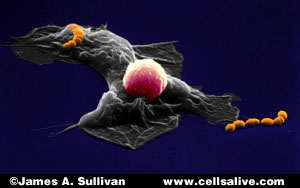|
In 1986 a man in Japan, Shirechiyo Izumi, reached 120 years, 237 days. He died after developing pneumonia. So in the end his
immune system failed as one of the many bacteria or viruses that cause pneumonia broke through the elaborate, natural defenses
that protect humans from infection. Scientists have long known that these defenses decline with age. Now some of the underlying
mechanisms are coming to light.
A multiplicity of cells, substances, and organs make up the immune system. The thymus,
spleen, tonsils, bone marrow, and lymphatic system, for example, produce, store, and transport a host of cells and substances:
B-lymphocytes and T-lymphocytes, antibodies, interleukins, and interferon, to name a few. Several are of special interest
to gerontologists. These include the white blood cells or lymphocytes, which fight invading bacteria and other foreign cells.

|
 |
|

Baltimore Longitudinal Study of Aging
The NIA supports the Baltimore Longitudinal Study of Aging (BLSA), America's longest-running scientific study of human aging,
begun in 1958. BLSA scientists are learning what happens as people age and how to sort out changes due to aging from those
due to disease or other causes. More than 1,200 men and women are study volunteers. They range in age from their 20s to their
90s. Visit this site and tap into their vast resources.
|
|
|
|
|
|


